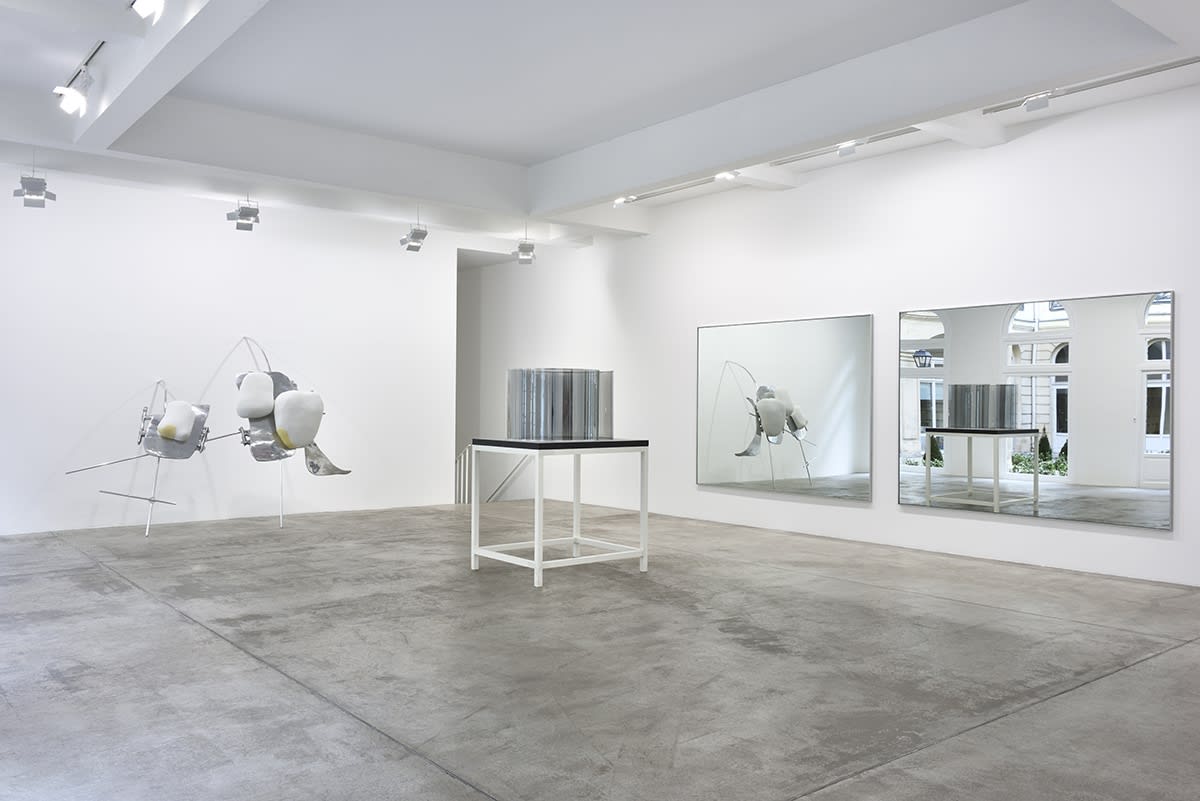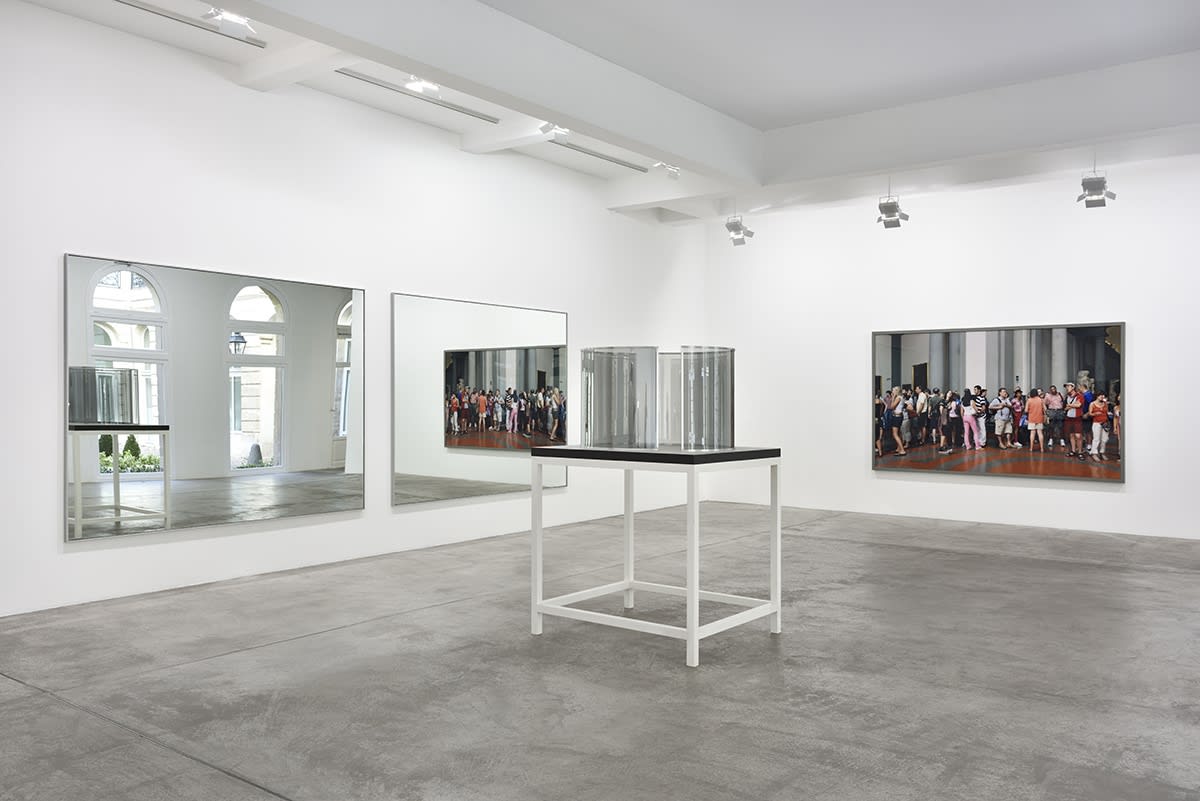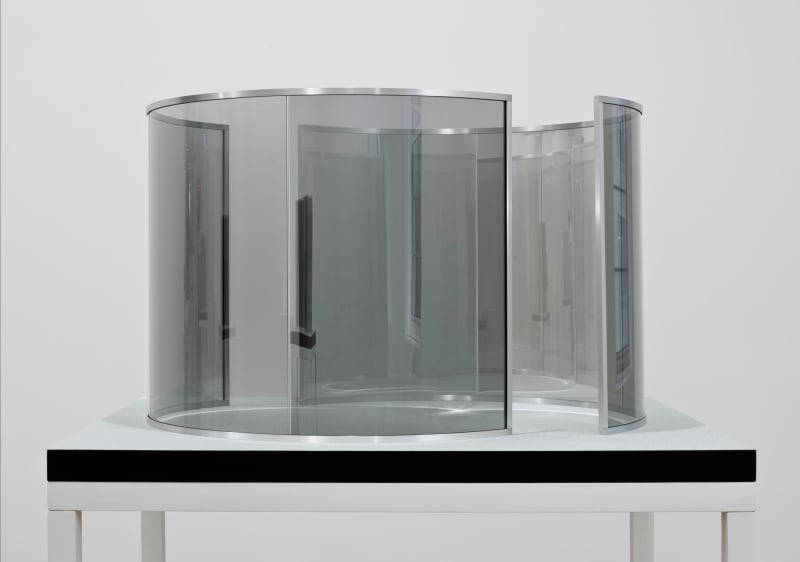Overview
Giovanni Anselmo, Nairy Baghramian, Dan Gramam, Tacita Dean, Gerhard Richter, Thomas Struth
January 12 – February 17, 2018
The sculpture Scruff of the Neck (LL 17/18/ +1, C), 2016 by Nairy Baghramian (born in Isfahan, Iran in 1971) is part of a series from 2016 where each work is differentiated by designations from dentistry: LL 17/18 or, in the case of other works in this series, LR 26/27/28 – presumably ‘lower left’ and ‘lower right’. Baghramian’s work co-opts some of these forms, but scaled as if the skull were the size of the gallery space. Her materials – cast and polished aluminum, polished aluminum rods, plaster, beeswax and rubber – have the sheen and monochrome palette of minimalist sculpture, but the references to the body are inescapable. Rendered bizarre by their gigantic translation from micro to macro, the objects are abstracted from their original function, nevertheless giving viewers a peculiar impression, alternating from a seductive formal presence to a slightly cringing memory of their real-world associations. A sensation of ongoing instability is discernable with the use of geometric and sharp forms confronted with smoother and rounder shapes. By polishing the surface of her materials, Baghramian gives them a soft appearance, adjusting their initial roughness and turning it into something more delicate. Nairy Baghramian has been living and working in Berlin since 1984.
Gerhard Richter (born in Dresden, Germany in 1932) has often reflected upon the mirrored surface and the ambivalent truth of representation throughout his career. In 1981, he created the original Spiegel (Mirror), which was followed in 1989, with the one presented here, Spiegel (Mirror), 687-5/6, 1989/2016. Once installed, Richter’s mirrors alter the boundaries of the room, and change the viewer’s perception of space. The viewer is sinking into an immersive experience, loosing stability within the space. He creates the effect of a pictorial and formal displacement, generating yet another dual discontinuity as “based on Richter's ongoing critique of painting as a form of illusionistic picturing."[1] Through the Mirror works, one can understand the extension and complexity of the artist’s language and his ongoing interest in addressing the impossibility of a single, truthful representation. Richter affirms that for him, “the pleasant thing is that it [the mirror] makes the pictorial space even more variable and more subject to chance than it is in photography […] this is the only picture that always looks different. And perhaps there is an allusion somewhere to the fact that every picture is a mirror.”[2] Gerhard Richter currently lives and works in Cologne, Germany.
Since the late 1970s, Thomas Struth (born in Geldern, Germany in 1954) has been creating photographs about humanity, its rituals and its relationship to the physical world. A student of Gerhard Richter and Bernd and Hilla Becher at the Kunstakademie Düsseldorf, Struth blends documentary photographic methods, technological innovation, and conceptual strategies of display. In his Audiences series, Struth addresses art, tourism, and spectatorship. Starting in 1989, the year in which Uffizi I, Florence was photographed, Thomas Struth's museum pictures have depicted architectural monuments and museum interiors—rooms of history—in relation to their audience, in which the subjects themselves become part of the portrait. Struth's pictures, in which the artist inverts his gaze transposing it to the viewpoint of the artwork, permits a singular exploration of new subject matter. In the case of Audience 9 (Galleria Dell' Accademia), Florenz, 2004, the larger-than-life statue of Michelangelo’s David isn’t included within the frame of the photograph. Yet, its aura is somehow reflected in the visitors’ sculptural postures and their upturned gazes. Struth’s idiosyncratic perspective makes visible the various aesthetic and social aspects that determine how art is approached and perceived: the relationship, for instance, between institutional space, art and a public whose reaction ranges from the boredom of guided group tours to a quasi-religious devotion. Struth’s pictures are neither staged nor digitally modified. Thomas Struth lives and works in Berlin, Germany.
American conceptual artist Dan Graham (born in Urbana, Illinois in 1942) produces artworks that often tend to blur the line between sculpture and architecture. Since the 1980s, Graham has been working on an ongoing series of freestanding, sculptural structures called Pavilions; they represent a hybrid between a quasi-functional space and an installation that serves to expose processes of perception. For some pavilions, Graham produces small-scale models using the exact same materials: stainless steel and two-way mirror. The model Two Half-Cylinders Off-Aligned, 2000 is placed in the center of the main gallery. Through the fluctuating reflections on their glass curves, Dan Graham's pavilions and models function as complex instruments of perception revealing to viewers their own bodies and themselves as perceiving subjects. The dual phenomena of spectatorship and spectacle that characterize contemporary urban social experience are here superimposed in front of a calm courtyard, which perhaps holds the memory of a state of being before the fracturing and de-centering of the modern subject. Dan Graham lives and works in New York.
In the showroom, Giovanni Anselmo (born in Borgofranco d’Ivrea, Italy in 1934) first emerged as part of the Arte Povera group in the second half of the 1960’s, while his research was focusing at the time on the constant dialogue between the visible and the invisible. The visible materials are either natural or industrial elements, often seemingly modest, including light projectors, magnetic needles, granite stones, photographs, dirt, and ultramarine blue paint. His invisible materials include magnetic fields, gravitational force, and the surrounding space. This work entitled Oltremare, 2017 evokes his views on how color can be conceived as matter and as energy. Ultramarine blue has indeed played an important role in Anselmo’s practice since 1979. The pigments are produced from ground lapis lazuli, which for Anselmo means that the color originally comes from raw minerals, and can thus count as matter. The artist Giovanni Anselmo lives and works in Italy where he splits his time between Turin and Stromboli.
Finally, the series of photographs GAETA, 2015 – Fifty photographs, 2015 by Tacita Dean (born in Canterbury, England, 1965) were taken in Cy Twombly’s studio in the harbor town of Gaeta, some 60 miles north of Naples, in 2008. Dean had invited Cy Twombly to select the photos himself which were then published as a photo essay in Twombly’s catalogue for his exhibition at MUMOK in Vienna in 2009. In 2015, on being offered the last available Cibachrome photographic paper (color photographs made photochemically from transparency), Dean decided to use the paper to realize the essay as a photographic series. She extended this work to include various photochemical processes and papers also under threat of disappearance. They are here presented as a photographical series on Cibachromes using a variety of papers differing in size and matt or glossy qualities. This body of work appears as a testimony of the artist’s inclination towards non-digital printmaking processes. These photos seem so redolent of life, one experiences a palpable sense of loss or absence at the thought that Twombly died in 2011, three years after these photos were taken. Tacita Dean currently lives and works in Berlin.
[1] Cook, Lynne, Gerhard Richter and Jorge Pardo: Refraction, Dia Art Foundation, New York, 2002
[2] Obrist, Hans Ulrich, Life of the Artists, Life of the Architects, Penguin, London, 2007











